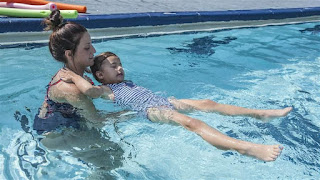Rural residents are three times as likely to die from drowning as their urban counterparts, according to a Canadian study published in 2013 in the International Journal of Aquatic Research and Education, reports Health Day. Researchers from St. Michael's Hospital in Toronto concluded that rural residents are more likely to be around open water and less likely to have taken swimming lessons. (Advocate Messenger photo by Clay Jackson: Swim instructor Emily Anderson helps four-year-old Addison Carr float at the Bunny Davis Recreational Complex in Danville, Ky.)
Despite those numbers—and equally alarming ones that say that drowning is the second leading cause of death for children under 5 and the second leading cause of accident by injury for those under 15—"public health advocates and researchers complain that state and local governments aren’t doing enough to prevent drowning deaths," Michael Ollove reports for Stateline. While the Minnesota Legislature "is studying a proposal that would
require that all public school students be given access to free swim
lessons," few states have considered similar proposals.
"Critics say most states don’t have sufficient laws or don’t enforce laws that could lessen the chances of drowning, such as requirements for fencing around private pools and the presence of trained lifeguards," Ollove writes. "And, they say, too little is being done to make sure that children have swim lessons and water safety skills."
The Centers for Disease Control and Prevention reports "that 3,391 people died by accidental drowning in the U.S. in 2013, about the norm in the years since 2000," Ollove writes. "Of the 2013 drownings, 625 were children under 15 . . . Injury and swimming experts such as the Red Cross say the best way to reduce the risk of drowning is by making sure that people know how to swim, although exactly how that can be accomplished for all is elusive."
One state that has taken the initiative to educate youngsters about safety is Washington, where most drownings occur in lakes, rivers and the ocean, not swimming pools, Ollove writes. The state "requires that all children under 13 wear a U.S. Coast Guard-approved life preserver in any boat that isn’t anchored and is less than 19 feet in length. The law also requires that all water skiers wear life jackets." According to the Red Cross, 80 percent of the nation's 418 reported boat-related drownings involved victims not wearing life preservers.
"Washington state also launched the nation’s first life preserver loaner program in the early 1990s, making life preservers available for borrowing at 180 sites," Ollove write. "The idea has taken off, and, according to the Sea Tow Foundation for Boating Safety and Education, by 2013, at least 44 state agencies or boating safety organizations had life jacket loan programs at nearly 2,000 lakes, rivers and beaches across the U.S." (Read more)

No comments:
Post a Comment